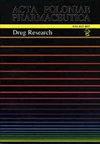Protective effect of the extract from Aronia melanocarpa L. berries against cadmium-induced oxidative stress in the kidney: A study in an in vivo experimental model
IF 0.4
4区 医学
Q4 PHARMACOLOGY & PHARMACY
引用次数: 0
Abstract
The destructive impact of cadmium (Cd) on the oxidative/antioxidative status of the kidney, as well as the possible beneficial effect of co-administration of a 0.1% aqueous extract from Aronia melanocarpa L. berries (AM), were studied in a rat model of low-level and moderate general population exposure to this heavy metal (1 and 5 mg Cd/kg feed, respectively, for up to 24 months). Total antioxidative status (TAS) of the kidney and the main indices of the enzymatic (superoxide dismutase, catalase, glutathione reductase, and glutathione peroxidase) and non-enzymatic (reduced glutathione and thioredoxin) antioxidative barrier were assessed. The total oxidative status (TOS) and concentrations of hydrogen peroxide, xanthine oxidase, myeloperoxidase, and oxidized glutathione were measured as markers of oxidative status. The oxidative stress index (OSI) was calculated (TOS/TAS) to estimate the intensity of oxidative stress in the kidney. The exposure to Cd, dose- and duration-dependently, weakened the enzymatic and non-enzymatic antioxidative potential of the kidney leading to a decrease in its TAS, as well as enhanced oxidative status of this organ resulting in the development of oxidative stress. The administration of AM during the low-level and moderate intoxication with Cd significantly protected from this xenobiotic-induced disruption of the oxidative/antioxidative balance and development of oxidative stress in the kidney. In summary, even low-level long-term exposure to Cd may result in the occurrence of oxidative stress in the kidney, whereas supplementation with chokeberry products may improve the oxidative/antioxidative balance preventing oxidative stress in this organ.黑桫椤浆果提取物对镉诱导的肾脏氧化应激的保护作用:体内实验模型研究
研究了镉(Cd)对肾脏氧化/抗氧化状态的破坏性影响,以及同时服用0.1%黑栎莓(AM)水提取物可能产生的有益作用,在低水平和中等水平暴露于这种重金属的大鼠模型中(分别为1和5 mg Cd/kg饲料,长达24个月)。评估肾脏总抗氧化状态(TAS)及酶促(超氧化物歧化酶、过氧化氢酶、谷胱甘肽还原酶、谷胱甘肽过氧化物酶)和非酶促(还原性谷胱甘肽和硫氧还蛋白)抗氧化屏障的主要指标。测定总氧化状态(TOS)和过氧化氢、黄嘌呤氧化酶、髓过氧化物酶和氧化谷胱甘肽的浓度作为氧化状态的标志。通过计算氧化应激指数(TOS/TAS)来估计肾脏氧化应激的强度。暴露于Cd(剂量依赖性和持续时间依赖性)会削弱肾脏的酶促和非酶促抗氧化潜能,导致其TAS降低,并增强该器官的氧化状态,导致氧化应激的发展。在低水平和中度镉中毒期间,AM的施用显著地保护了这种外源性诱导的氧化/抗氧化平衡的破坏和肾脏氧化应激的发展。总之,即使长期低水平暴露于Cd也可能导致肾脏氧化应激的发生,而补充蔓越莓产品可以改善氧化/抗氧化平衡,防止肾脏氧化应激。
本文章由计算机程序翻译,如有差异,请以英文原文为准。
求助全文
约1分钟内获得全文
求助全文
来源期刊
CiteScore
0.80
自引率
0.00%
发文量
74
审稿时长
6-12 weeks
期刊介绍:
The international journal of the Polish Pharmaceutical Society is published in 6 issues a year. The journal offers Open Access publication of original research papers, short communications and reviews written in English, in all areas of pharmaceutical sciences. The following areas of pharmaceutical sciences are covered: Analysis, Biopharmacy, Drug Biochemistry, Drug Synthesis, Natural Drugs, Pharmaceutical Technology, Pharmacology and General.
A bimonthly appearing in English since 1994, which continues “Acta Poloniae Pharmaceutica”, whose first issue appeared in December 1937. The war halted the activity of the journal’s creators. Issuance of “Acta Poloniae Pharmaceutica” was resumed in 1947. From 1947 the journal appeared irregularly, initially as a quarterly, then a bimonthly. In the years 1963 – 1973 alongside the Polish version appeared the English edition of the journal. Starting from 1974 only works in English are published in the journal. Since 1995 the journal has been appearing very regularly in two-month intervals (six books a year). The journal publishes original works from all fields of pharmacy, summaries of postdoctoral dissertations and laboratory notes.

 求助内容:
求助内容: 应助结果提醒方式:
应助结果提醒方式:


